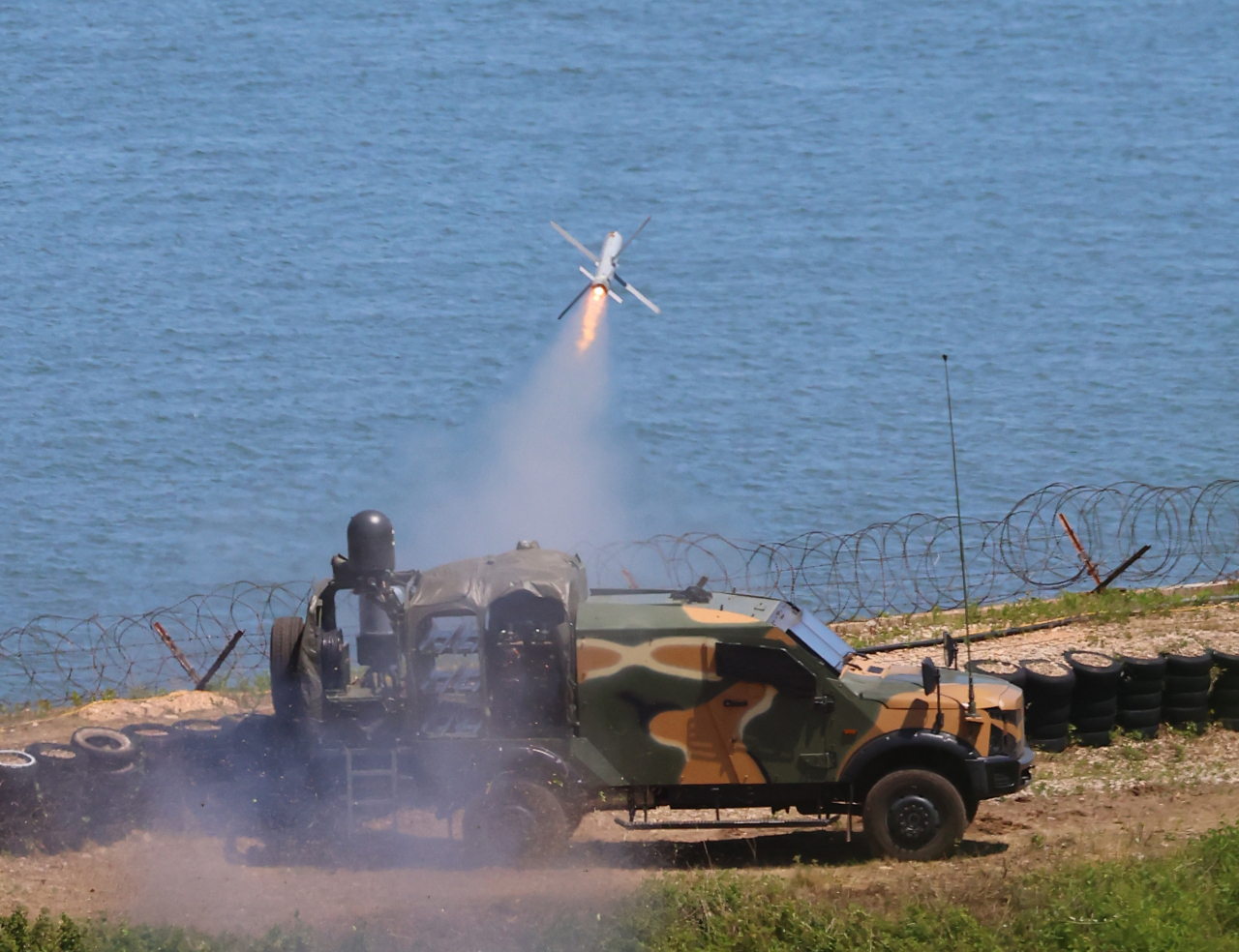 |
A South Korean Marine Corps tank fires a missile into the waters off Yeonpyeong Island, south of the maritime border with North Korea, in the first such drills held in six years and 10 months, Wednesday. (Yonhap) |
For the first time since the beginning of the Moon Jae-in administration in August 2017, South Korea’s Marine Corps on Wednesday conducted live-fire drills from islands south of the sea border with the North.
The full-scale live-fire drills came after South Korea suspended the 2018 inter-Korean pact for reducing front-line tensions, which had been reached as part of Moon's North Korea appeasement policy.
Following an attempted launch of another military reconnaissance satellite by North Korea last month, South Korea said it would do away with the pact to restore border military activities until “trust is restored.”
According to the South’s Marine Corps, the Wednesday drills -- involving the K239 Chunmoo multiple-launch rocket system and K9 Thunder howitzers -- included troops firing more than 290 rounds at targets in the sea off the islands.
“These are the first sea drills to be staged in the northwestern islands after the 2018 military pact was fully suspended due to North Korea’s recent provocations including missile firings,” the Marine Corps said in a release.
“Today marks the beginning of regular maritime drills to be held to improve the Marine Corps’ firepower operation capabilities and complete our readiness.”
As the 2018 pact barred such military action in the maritime buffer zone, the Marine Corps held the sea drills on land for the last six years.
The drill was conducted hours after North Korea test-fired a missile, believed to be a solid-fuel hypersonic ballistic missile, over seas east of the country early Wednesday. But the missile failed to fly its intended path and fell into the water after exploding midair, according to the South Korean military.
South Korea’s Joint Chiefs of Staff said that the missile was fired from Pyongyang at around 5:30 a.m. toward the sea, possibly using a transporter erector launcher for carrying missiles.
The JCS said that the ballistic missile was fired toward Alsom, an uninhabited island off the coast of North Hamgyong Province, and flew about 250 kilometers east before landing off the coast of Wonsan, Kangwon Province.
In response to press questions, a JCS official said it was “possible that the missile had been a hypersonic intermediate-range ballistic missile with a solid-fuel engine.”
“It is possible that North Korea may have tested something a little more advanced this time, after announcing in January and April that they confirmed the reliability of their solid-fuel engines,” the official said.
Earlier this year, North Korea tested solid-fueled hypersonic ballistic missiles, fired from Pyongyang on Jan. 14 and then again on April 2. They flew for about 1,000 kilometers and 600 kilometers, respectively.
The smoke from Wednesday’s launch was visible to the naked eye from the Greater Seoul area, raising the possibility that the missile had suffered some problems with its engine.
“The missile launched on this day emitted more smoke than usual, and it didn’t fly properly,” the JCS official said.
The official said that North Korea’s hypersonic ballistic missiles appear to be “still in the process of being tested until they can be fully operational.” “Weapons systems usually go through a lot of trial and error before they are ready to be put to use,” the official added.
The last time North Korea tested a ballistic missile was about four weeks prior, when its “super large” KN-25 was fired on May 30.
Wednesday’s missile launch also comes after North Korea launched hundreds of balloons carrying trash to South Korea for two consecutive days on Monday and Tuesday.
Most of the balloons fell in and around Seoul, causing flight delays at Incheon Airport near the border. Some of the balloons landed at key landmarks, including the National Assembly, according to police.
North Korea has sent trash-carrying balloons on six separate occasions so far, with South Korean authorities having found them to contain parasites in the first round of analysis.
Amid a series of provocations by North Korea, South Korea’s top nuclear envoy Lee Jun-il held talks over the phone with his US and Japanese counterparts Wednesday morning to discuss a joint response to missile and other threats.
According to the Foreign Ministry in Seoul, the three nuclear envoys talked about close cooperation in responding to future provocations by North Korea in the aftermath of the summit with Russia in Pyongyang.








![[Herald Interview] 'Trump will use tariffs as first line of defense for American manufacturing'](http://res.heraldm.com/phpwas/restmb_idxmake.php?idx=644&simg=/content/image/2024/11/26/20241126050017_0.jpg)
![[Health and care] Getting cancer young: Why cancer isn’t just an older person’s battle](http://res.heraldm.com/phpwas/restmb_idxmake.php?idx=644&simg=/content/image/2024/11/26/20241126050043_0.jpg)
